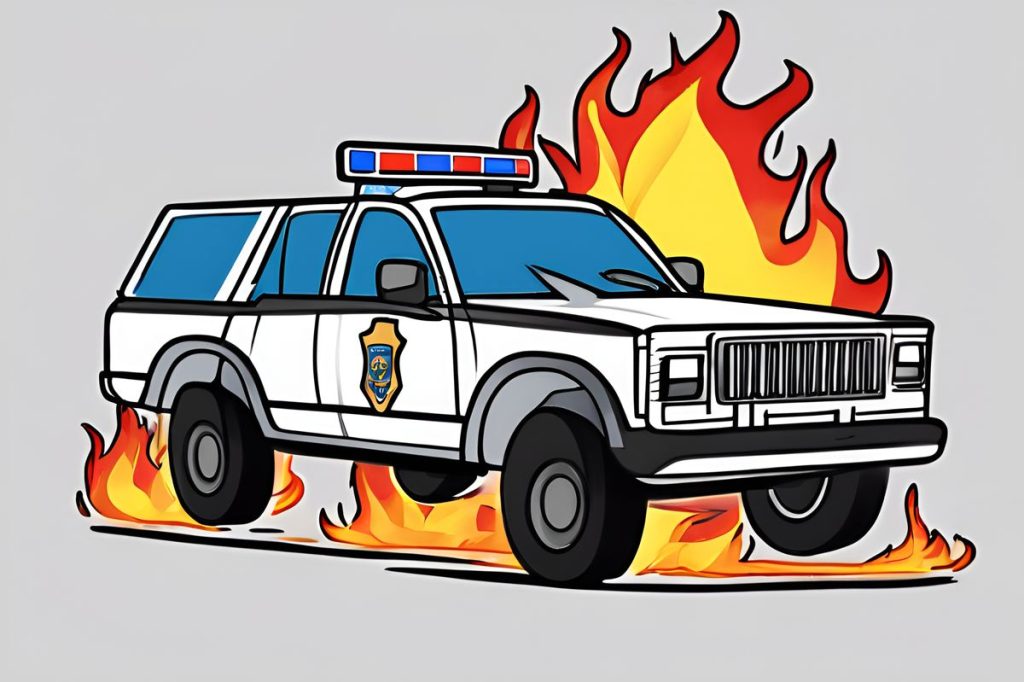The escalation of violence on Easter Saturday in the Limassol district saw a group of youths armed with Molotov cocktails firebombing a police vehicle between Ypsonas and Erimi, leading to a clash with riot police who had to use tear gas to control the situation. Despite material damage to police property, no injuries were reported, and an investigation is ongoing to apprehend those responsible for the reckless endangerment of public safety.
What happened on Easter Saturday in the Limassol district between Ypsonas and Erimi?
On Easter Saturday in the Limassol district, violence escalated when a group of youths armed with Molotov cocktails firebombed a police vehicle. Riot police were attacked with firecrackers and rocks, and had to use tear gas to control the situation. Despite material damage to police property, no injuries were reported. An investigation is underway to apprehend those responsible.
Unrest on Easter Saturday
On a night meant for peaceful reflections, chaos erupted on the streets between Ypsonas and Erimi in the Limassol district. An alarming situation developed as authorities were alerted about a large group of youths, reportedly armed with Molotov cocktails. These makeshift incendiary devices posed a severe threat not only to property but also to the lives of residents and passersby. The group’s brazen actions escalated quickly, culminating in a violent confrontation with law enforcement officers.
As the night unfolded, the gathered crowd’s actions turned destructive. Vehicles passing by became targets for the youths’ Molotov cocktails and firecrackers. The intent to disrupt and intimidate was clear, and the situation necessitated a swift response from the authorities to prevent further harm or potential loss of life.
Clash with Riot Police
The response was met with further aggression when riot police reached the scene. Approximately 100 individuals began hurling Molotov cocktails, along with firecrackers and rocks, in a direct assault on the officers. In a bid to control the situation and restore order, the police were forced to deploy tear gas. The chaos peaked when the mob set a police vehicle ablaze, leading to its complete destruction.
Despite the volatile environment, the police acted with restraint and managed to avoid any escalation that could have led to severe injuries or fatalities. Such events highlight the dangers that law enforcement officers face, especially when confronted by large, hostile groups. The aftermath of the incident saw material damage to four additional police cars, though no injuries were reported.
Aftermath and Investigation
The aftermath of the violent outbreak saw the crowd disperse rapidly as the tear gas took effect, providing a temporary respite from the onslaught. In the wake of the dispersal, the police discovered two bottles containing flammable liquid, remnants of the night’s chaos, which they secured as evidence. These items will play a crucial role in the ongoing investigation as authorities seek to identify and apprehend those responsible for the reckless endangerment of public safety.
In law enforcement, the ability to investigate and process a crime scene is paramount. It involves collecting evidence, canvassing for witnesses, and piecing together the sequence of events. No arrests have been made in the immediate aftermath, indicating the challenges faced by the police in managing such a large and volatile group effectively. The investigation continues with the aim to bring those involved to justice and to deter future incidents of this nature.
Importance of Civil Order
Incidents like these serve as stark reminders of the thin line between civil order and chaos. The societal cost of such disruptions is significant, impacting not just property but the very fabric of community safety and well-being. The ability of law enforcement to respond and control such situations is critical in maintaining public trust and ensuring that peace prevails over violence.
The ongoing investigation will delve into the motives behind such actions and hopefully lead to measures that prevent similar occurrences in the future. It requires a collective effort from community leaders, local authorities, and residents to foster an environment where differences are settled through dialogue rather than violence.
What happened on Easter Saturday in the Limassol district between Ypsonas and Erimi?
On Easter Saturday in the Limassol district, violence escalated when a group of youths armed with Molotov cocktails firebombed a police vehicle. Riot police were attacked with firecrackers and rocks, and had to use tear gas to control the situation. Despite material damage to police property, no injuries were reported. An investigation is underway to apprehend those responsible.
How did the clash with riot police unfold during the escalation of violence?
Approximately 100 individuals began hurling Molotov cocktails, along with firecrackers and rocks, directly at the riot police officers. In response, tear gas was deployed to control the situation. The violence reached its peak when a police vehicle was set ablaze and completely destroyed. Despite the intense confrontation, no injuries were reported.
What was the aftermath of the violent outbreak and how is the investigation progressing?
Following the dispersal of the crowd, police discovered two bottles containing flammable liquid, which were secured as evidence. The investigation is ongoing to identify and apprehend those responsible for endangering public safety. No arrests have been made at this point, highlighting the challenges faced by law enforcement in managing such volatile situations effectively.
Why is maintaining civil order important in the face of such incidents of violence?
Incidents of violence like the one on Easter Saturday in the Limassol district underscore the importance of maintaining civil order. Such disruptions not only impact property but also community safety and well-being. It is crucial for law enforcement to respond effectively to such situations to uphold public trust and deter future acts of violence. A collective effort from community leaders, local authorities, and residents is necessary to prevent similar occurrences and promote peaceful resolution of conflicts.

